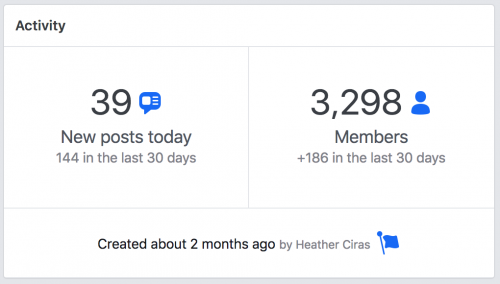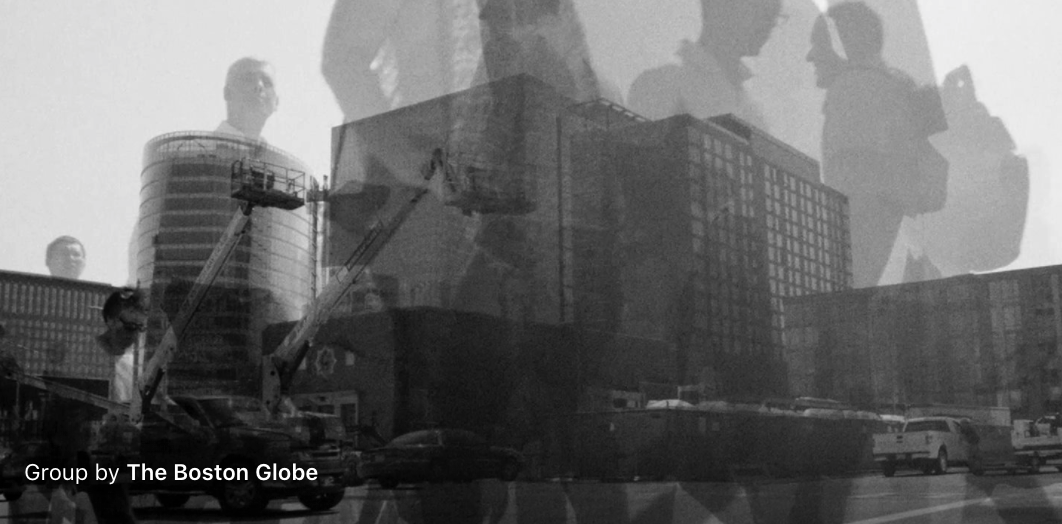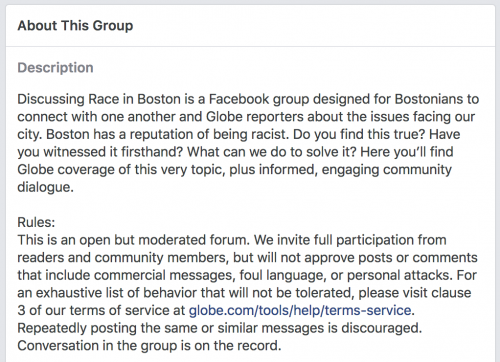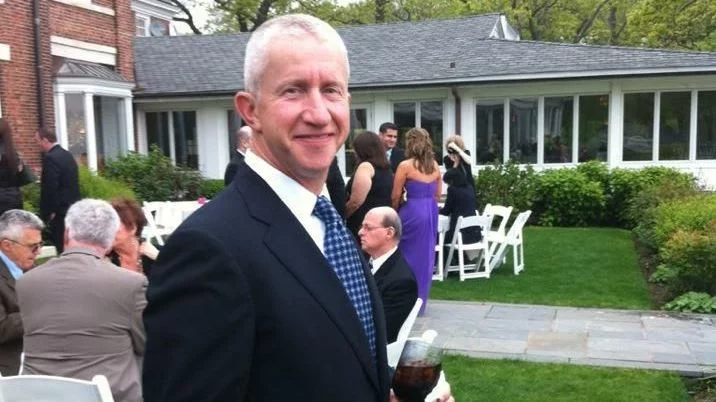Moderating the masses: How the Boston Globe guided discourse about race in Boston
Hosting an open forum online about race sounds like every PR person’s worst nightmare. But not for Heather Ciras, The Boston Globe’s audience engagement editor, who led a discussion in response to the Spotlight team’s series “Boston. Racism. Image. Reality.”
The series posed a question that’s haunted Boston for decades: Does this city deserve its racist reputation? The Spotlight team spent months collecting data and conducting deep investigative research. Ultimately, it was the people of Boston, not The Globe, who needed to answer this question.
Ciras opens up about mediating the article’s Facebook page and comments and how her team determined their ethical boundaries.
What strategies did you come up with, as the social media director, to facilitate a dialogue about race in Boston after “Boston. Racism. Image. Reality” was published?
We had to answer a few questions. How do we connect with the community, especially as a larger metro newspaper, our priority is for the people of New England and Boston. How can we make sure the most people read this, but also how can we make sure we’re making a connection with the community? How can we amplify local conversation? How can we make sure that this project is starting a thoughtful discussion about race in Boston?
How do you think this sort of community dialogue is important, if you do think it’s important, for this topic specifically?
Race is so hard to talk about. Usually at the bottom of articles there are spaces for people to say whatever they want, and we wanted to help guide that so that it didn’t devolve into terribleness. We did two things. First, we knew we wanted to do a Facebook group, and Facebook groups are hard because you can’t just do it for every one-off story. You have to put institutional commitment into it. We had people from the Spotlight team in the Facebook group for the duration of the project. Simultaneously, a reporter was starting on the social justice beat, and it was perfect timing to have her and some other reporters who regularly report on race to join the group. Initially we wanted to launch this group, start a conversation, and have reporters and editors in there, and eventually bring in reporters who were doing long term reporting on race. Everyone is monitoring the heck out of it.
What are some of the ethical issues you face while mediating the social media discourse for this piece?
You have a lot of questions to face. How do I communicate whatever I’m trying to say to the group? Do I have an editor to look it over? What are our policies? How do I make sure everything I’m doing is in line with Globe standards? We wanted to engage conversation with a diverse amount of viewpoints. We don’t allow things like racial slurs, name calling, or even conversations that led people of color to defend their humanity, or put people of color always on the spot to educate the rest of the group. We had a lot of discussions about what was and wasn’t an acceptable post or whether we should delete comments from people who went over the line, or if we had to remove people from the group who were being belligerent or nasty. We only had to remove a few.
“A big part of the planning and execution revolved around making sure that the voices of people of color were amplified and respected.”
Maybe most importantly, though, a big part of the planning and execution revolved around making sure that the voices of people of color were amplified and respected. I’m white, and I never wanted my voice, or those of the engagement team in general, to be dominant in the group. I also didn’t want white people in the group to shut down or drown out black people, and I also didn’t want the onus to be on the black members of the group to teach everyone else everything. So there was a lot to balance. I can’t say that everything was perfect; we’re humans and we’re messy, and talking about race is hard and the people involved have to be honest and kind of vulnerable if we’re going to really connect. I do think a lot of good happened and is still happening in that group.
I was also very conscious that we are not creating a new conversation for the city. Black Bostonians and their allies have been doing the work toward greater equality in the city forever. What we did, having a weeklong conversation about how racism still exists in Boston, was just a very small part of what is happening in the city to make it more equitable for all residents.
What is the line? What does the Globe define as OK and not OK?
It was really hard to know, so we had a lot of conversations in advance about what would and wouldn’t be allowed. I think the hard part was deciding what is and isn’t okay in our culture in general right now. There was no outright racism in the group, and yet we had a couple posts that were about welfare issues and pointing the finger at people of color. And things like that just devolved into racial stereotyping. Those words were coded to often mean something much more nefarious. There were a couple instances when people were name calling and people had to be removed. More often the problem was when people were trolling and commenting repeatedly in a sarcastic manner and shutting down conversations. That was more of an issue than any sort of racist commentary.
I also think the group was kind of self-selecting. If people don’t think race is an issue in Boston, I don’t think they would have joined a group that discussed race as an issue in Boston. For the most part it’s been unbelievably respectful and positive. I was worried. You never know what’s going to happen. But within 24 hours it blossomed into this amazing platform where people could talk about the Spotlight series but also share other things and personal experiences.
Do you think The Globe did a good job at targeting people who disagree that racism is an issue and probably should be exposed to this discourse the most?
First, I hope the series itself was a way of targeting the people who don’t think racism is an issue in Boston. The Spotlight team was very intentional to approach this topic without bias, and truly used the question “Does Boston deserve its racist reputation?” as a guide to their reporting. It was a creative and nontraditional topic for an investigative team.
The goal for the Facebook group was to facilitate the connection between us and the community, so we didn’t have any preconceived notions about who we thought would want to join the group. We really didn’t know what we were getting ourselves into, but we felt the opportunity for real connection was so great that it was worth the risk. We were very lucky that the risk paid off. We have almost 3,400 members, and hundreds of posts and thousands of comments. And the number of negative interactions is probably .02% of the whole.

In the group, we didn’t see an onslaught of people arguing that the Spotlight series wasn’t addressing a real problem of racism in Boston. But we did see people push back on certain points, and, I think, came away with a good understanding of how the reporting and research was conducted. If they weren’t people of color, I hope they also have a better understanding of the black experience in Boston. So the topics they were debating in there — one that comes to mind is, is the seaport’s almost complete lack of diversity really racist or does it just favor rich people, regardless of race? — didn’t feel like we were in a liberal bubble.
The commenting system that we set up through The Coral Project was a place where people who outright disagreed with the Spotlight series certainly felt comfortable to say so. So there was a place for them, even if they weren’t gravitating to the Facebook group. And you can see by looking at the comments, we approved anything that was constructive, even ones that called us wrong and sometimes worse.
Should readers expect to see more of this type of direct dialogue in future Globe pieces?
I think we would do this again. We have another Facebook group for our subscribers, which has been really successful. People talk about what they like, what they don’t like. It’s a place to for reporters to interact with the readers. It holds us accountable. People can say, “This stunk” or “Why did you report it this way?” and reporters can either defend it or chime in on whether they find that acceptable.
It takes a lot of time and effort. It’s not something you can take lightly. We’ve had lots of conversations about it. We also partnered with the Coral project. If you go into any of the Spotlight commenting sections, they’re not the same as the comments on our other stories. We worked with Coral and basically we got to pose a question to people instead of just having an open call for people to throw out there. So for example, “Do you think Boston has a racism issue?” and then people would go in and respond, and then the social media team and the Spotlight team would go in and monitor those responses. Day one we got something like 750 responses and we approved about 600-something and most of the ones we didn’t approve we’re answers that only said “yes” or “no.” And that is exponentially more than our normal amount of comments.
What do you think the effects of these comments were?
Well, it’s hard to say. It was really great to have people from all over the country contributing their input. It’s always approbation. If you’re getting a lot of comments from people and making them respond and prompting them to go the step further. I’m always really humbled when people connect with the stories and take the time to respond to them.






